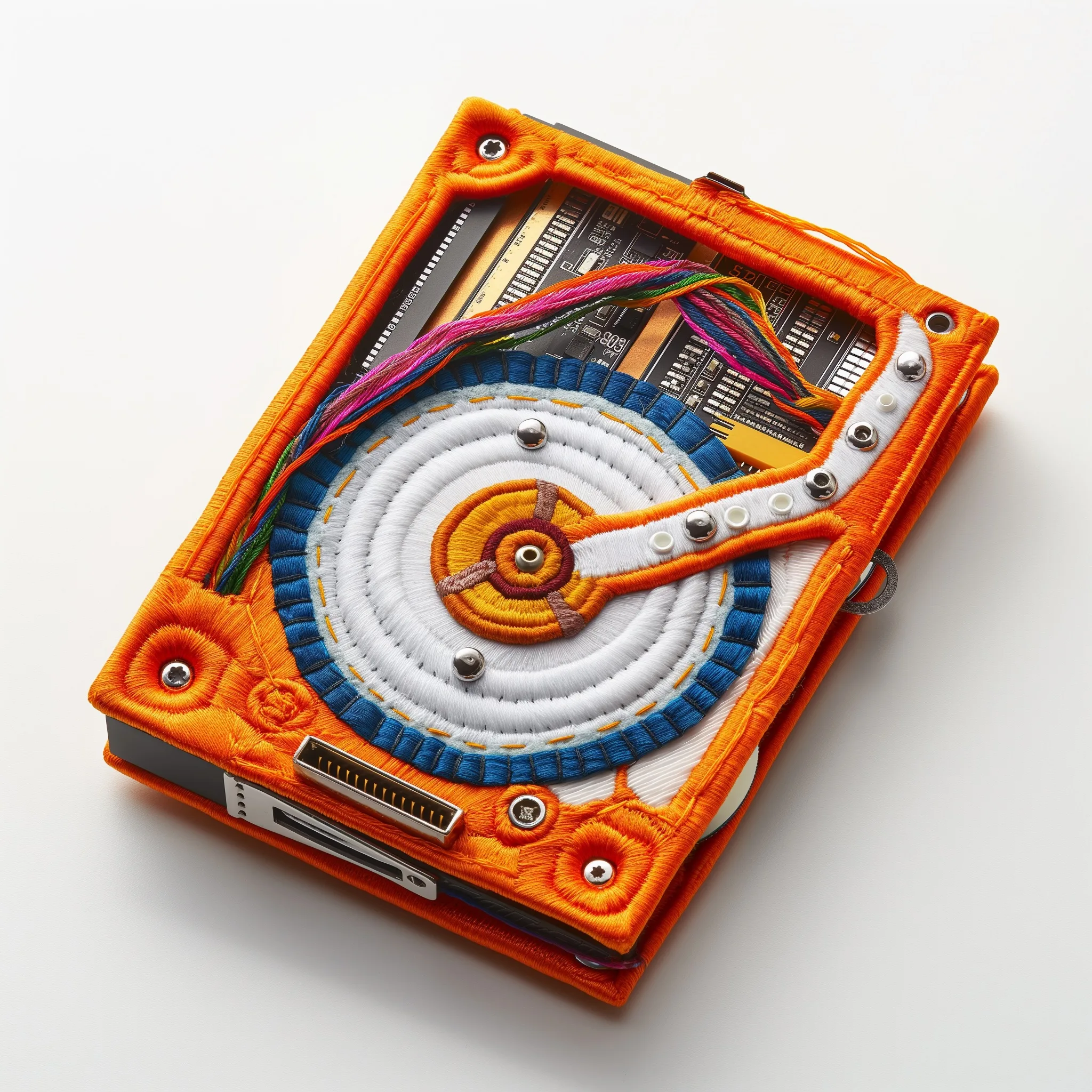
Artist renditions of what the New Time Rangers might have looked like (created with Midjourney)
The Legend of the New Time Rangers
Memory Pouches are fashion, utility, and time artifacts worn by time-minding members when they go out into the world. At their peak, the New Time Machines Working Group relied on a critical device that made their Time Rangers worthy of legend.
Memory Pouches were devices invented by the Working Group to enhance a wearer’s core attention and memory mechanisms. Equipped with their Pouches, Time Rangers were capable of tracking animals by tiny sounds, extracting precise ingredients from a single taste, and even identifying plants by their growth rhythms, through their attunement to time.
The Rangers were known to have extremely precise awareness of their environment and the beings that occupied them, and they used this power to uphold the balance of the natural world and its timeline.
The original formation of Memory Pouches consisted of six key components, one for each original human sense and one for the sixth sense of time: touch, sight, taste, sound, smell, and time.
Outside of this standard carry, each Time Ranger had personal Pouches customized to their desires and what they paid attention to. Detailed records of specific personal Pouches have not been recovered, but based on device fossils, it is known that some contained chalk, USBs, moss, and other combinations of natural and man-made materials.

TOUCH POUCH | A glove that molds to skin and endows fingertips with the ability to extract miniature samples from touched objects and materials. When a sample is desired, the wearer triggers the glove by wrapping their hand around the target object. The tool takes a 3D scan of the encased object, decomposes a tiny area of the surface being touched, and shapes the material into a spherical representation of the object about the size of a marble. These marbles are fed via vacuum into a housing compartment located above the wrist.

SIGHT POUCH | A tiny camera embedded in the wearer’s index finger that can be extended on command to take a picture. A slim rectangular printer, usually affixed to the belt, automatically prints a rapid physical impression. Photos are automatically compressed into the printer attachment for storage. Printer paper is composed of a synthetic material that maintains durability while being extraordinarily thin, such that the printer can store hundreds of photos at once.

TASTE POUCH | A retractable receptacle that derives the taste of an object from its chemical composition and transfers it to your brain, allowing the wearer to virtually taste without physical exposure to potentially dangerous substances. Tastes are automatically recorded on-device into a small memory and can be combined on the fly and transmitted to the wearer’s brain.

SOUND POUCH | A conch-shaped Pouch that serves as a repository for sounds. A button at the outer edge controls recording snippets, while a knob tunes noise reduction to isolate sounds properly. Located inside the conch, a microphone receives amplified sounds through the Pouch’s structure, enabling the capture of noises too soft for a human ear. For detailed capture, the wearer can extend the microphone towards a desired source. The Pouch fits in the palm of a hand and is typically worn as an earcuff.

SMELL POUCH | A pen-shaped Pouch that extracts smells from the air. Upon clicking the top, it collects a sample of chemical components from the air, recreates a dense miniature by maintaining the ratio of chemicals, and inscribes the concentrate onto a new evolution of the devices once known as “scratch-and-sniff” paper. Modeled after state-of-the-art perfume processes, this process simulates the creation of an “instant perfume.” The slips are automatically labeled and can be scratched at a later date to release their smell.

TIME POUCH | A clock pendant worn around the neck. This artifact serves as a connector for the other devices by recording detailed time logs when each Pouch is used, preserving the history of memory creation. The samples and their compositions are recorded and can be recreated using carbon printing even if the original sample is lost. By default, the watch face shows human clock time but can be tuned to show the timescale of any object, using the side knob. For example, tuning the device near a plant will change the watch face to reflect the lifecycle of the plant.
Memory Pouches Today
Due to the Time Reformation, we have lost the schematics for creating these devices. To make our own, we must find ways to recreate the device using present materials and techniques. In this guide, we will explore several ways to create Memory Pouches while preserving the rituals the New Time Machines Working Group developed in conjunction with these tools.
We aim to create devices that help us develop a more precise awareness of our senses and the environment we occupy. In doing so, we hope to honor the wonder and meaning inherent in our everyday experiences of the world.
Construction
You don’t need special materials to create a Memory Pouch. The most important aspect of creating a personal Pouch is choosing the materials according to your own judgment. In this process of choice, you imbue the container with the capacity to hold ritual memory.
- Gathering. Look in your own home and around your neighborhood for materials that could serve as Pouch containers. Promising starts include bags, hats, scarves, pockets, pots, bottles, cases, and other everyday objects that can be used to gather.
- Carrying. With attention to your chosen container, find a compatible material to make the container portable. If your container is already portable, say an existing bag with a handle or the pocket already attached to clothing you would wear, you can move on to the next step or look to enhance its portability further. Try out different materials by affixing them to your container and seeing how they hold up as you use them to carry it. Promising materials include carabiners, string, shoelaces, tape, clips, magnets, pins, and rubber bands.
- Naming. Designate your Pouch’s purpose by naming what it will collect. Come up with a category that you can use to easily qualify whether something fits with a yes/no question. Examples include: flower petals, paper scraps, tiny textured objects, coins, receipts, objects dropped on the ground by someone else.
While these steps are numbered, the order is merely a suggestion. Your Pouch creation can happen in any sequence and we recommend moving the steps around to see how it changes your creation process. For example, you could start by Naming and seek an appropriate container to honor the name.
Testing in Use
You’ve created your very own Memory Pouch! At this point, you should test wearing it and make sure it feels good on your person.
Take it out for a trial run the next time you go on a walk and pay attention to the purpose you’ve given it. Collect something and notice how it feels to deposit something into the Pouch.
You will likely have ideas for improvement after the trial. You can visit your local crafts store to make adjustments if you don’t have suitable material on hand. We suggest keeping a paper log of the containers you’ve designated as Memory Pouches and what they were made for, as a ritual in history preservation and honoring your acts of creation.
Sample Configurations
To give you an idea of how you might go about using Memory Pouches, here are four examples I was able to make using materials found around my room. As you can see, you don’t need special materials or skills to create your Memory Pouch. You don’t even have to create a new container—you can designate as a Pouch a pocket in a bag or on a piece of clothing that you already wear frequently. What’s important is your intent in honoring each Pouch’s purpose.1
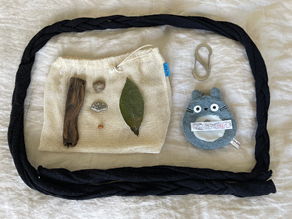

Utility Sling | The utility sling enables the wearer to carry several Pouches as they travel around in the wild. It is photographed here with two sample Pouches:
- Totoro Pouch: Attached to the scarf with the carabiner, the totoro Pouch collects small paper scraps that reflect events with friends. Notice the order receipt from a taqueria, filled out with event details depicted below.
- Textures bag (mesh bag): used to collect textures. Notice the driftwood, rocks from different trips, and the big leaf depicted below.
Materials: black scarf, Totoro Pouch, carabiner, mesh bag with fastener
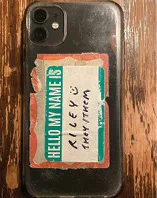
 Smell Box | The smell box is designed to capture a bouquet of smells from found material. Because it is a small enclosed container, it can condense the smells of organic material into a single blast upon opening. Regularly empty the contents to start anew to avoid smell decay, especially when working with living material. The sample contains a bouquet of orange, lavender, and eucalyptus. Materials: small plastic container with lid
Smell Box | The smell box is designed to capture a bouquet of smells from found material. Because it is a small enclosed container, it can condense the smells of organic material into a single blast upon opening. Regularly empty the contents to start anew to avoid smell decay, especially when working with living material. The sample contains a bouquet of orange, lavender, and eucalyptus. Materials: small plastic container with lid
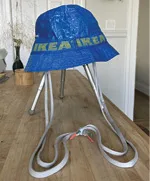
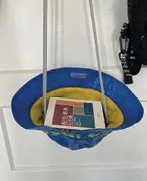
Hat Tote | The hat tote is is designed to convert between being worn on the head and worn across the chest when the wearer decides they want to collect. The sample is shown with tape to close the top because I didn’t have better fasteners available in my room, but it could be easily augmented with velcro or other everyday fastener supplies like binder clips. Materials: bucket hat, extra shoelaces, tape
Digital Pouches
As we spend more of our time online and thereby experience reality through digital devices, our memory is increasingly housed in digital brains rather than our physical ones: our phone photos, calendar events, online shopping receipts, and what we were writing and listening to on any particular day. Because the original Memory Pouches were created in a civilization that did not possess the graphical user interface, and instead focused their attention on advanced tactile technology, we can instead introduce practices that are designed to work through how we make memories with our digital augmentations.
To create your own, I recommend cultivating practices that mirror how we created our physical Pouches.
- Gathering: Create containers for collecting artifacts you encounter. Currently, I do this with ,2 creating different channels for topics and loose themes that feel palpable to me, ranging from Wikipedia links and free small tools to general things I want to remember. You could also use a note from your favorite notetaking app, an album in your camera roll, your texts with a person, your calendar, your social media profile feed, or voice memos, and much much more.
- Carrying: Embed these containers where they will be easily accessible when you are on the go. Place apps on your home screen. Cultivate taking screenshots and photos to capture things you notice.
- Naming: Name Pouches for their purpose or leave unnamed to function as temporary storage for uncategorized objects. Follow the same naming guidelines as with physical Pouches so that it is clear when something belongs in a digital Pouch.
- Ritualizing: Digital Pouches are uniquely capable of creating rituals around collecting at a specific rhythm. Our digital devices are always with us and can prompt us according to the cadence we care about. For example, you could take a selfie every day before the sunset or of the sunset itself, record every time you feel grateful for life, or document every drink that you order from a grocery store.
Take your Pouches out into the world and gather away!
Memory Exchange
Memory gathering, although inherently personal, is not a purely individual act. Our memories act as portals into details of our lives which can become sites of connection through shared remembrance. Whenever we collect memories, we are not only caring for our own sense of self but we are also creating openings for gathering with others around the things that we find meaningful.
Our collected objects become vessels for our memories that can be passed down, gifted, and exchanged. I encourage creating Memory Pouches as a communal activity and convening every few months to share and exchange the things you have found. When you pass on an object from one person to another, you multiply the inherent meaning and personality it carries.
Our memories can become bridges for connection over the inspiration embedded in our daily lives and environments.
Memory as Protocol
Memory is a protocol for ritualizing perception. What we see matters. What we pay attention to dictates what we believe happened. Our memories form the stories we tell both ourselves and the world, which makes developing methods to influence our memory an invaluable practice.
Rather than creating enough memory to remember everything as other technologies have done, Memory Pouches were originally developed as a human-first method for memory influence by forcing wearers to cultivate their own personal practice and relationship with different senses of memory.
In creating Pouches, we are forced to confront essential questions that are core to our identity: what do we care about? what do we want to see more of? and what do we think belongs as part of our histories? The Pouches we create and cultivate act as living excerpts of our memoirs. We are making room not only in physical space but also in time for the things that matter to us. And in doing so, we are writing our histories.
In a world overwhelmed by information, Memory Pouches offer an aid for anchoring our memory to tangible containers and objects so that we may all choose the memory that matters to us. Can remembering be a power that is granted and thus harnessed? And when harnessed, does memory give us the power to shape time itself?
We would love to see what you find. We have collected several proven practices into a Memory Pack, and encourage you to submit your own.
See also
Kei Kreutler, Artificial Memory & Orienting Infinity
summerofprotocols.com/research/artificial-memory-and-orienting-infinity
Nadia Asparouhova, Dangerous Protocols
summerofprotocols.com/research/dangerous-protocols
Aaron Lewis, Kei Kreutler, Alice Noujaim, Nahee Kim, & Spencer Chang, New Time Machines
summerofprotocols.com/research/new-time-machines
Rafael Fernández, The Swarm and the Formation
summerofprotocols.com/research/the-swarm-and-the-formation
Nadia Asparouhova, Dangerous Protocols
summerofprotocols.com/research/dangerous-protocols
1. Image credits this page: Riley Wong
© 2023 Ethereum Foundation. All contributions are the property of their respective authors and are used by Ethereum Foundation under license. All contributions are licensed by their respective authors under CC BY-NC 4.0. After 2026-12-13, all contributions will be licensed by their respective authors under CC BY 4.0. Learn more at: summerofprotocols.com/ccplus-license-2023
Summer of Protocols :: summerofprotocols.com
ISBN-13: 978-1-962872-62-1 print
ISBN-13: 978-1-962872-77-5 epub
Printed in the United States of America
Printing history: February 2024
Inquiries :: hello@summerofprotocols.com
Cover illustration by Midjourney :: prompt engineering by Josh Davis
«embroidered hard drive on a white background»
